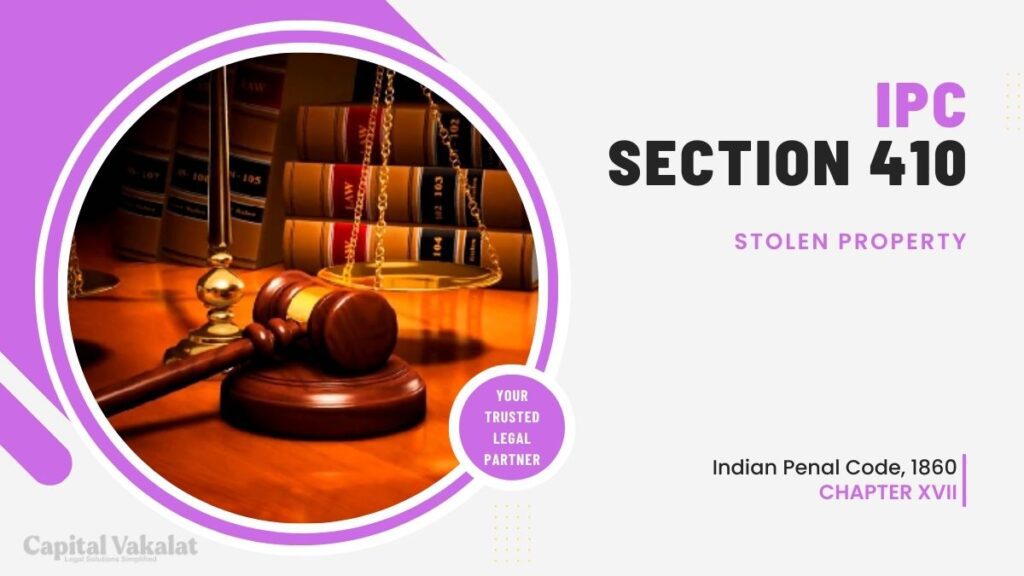Understanding the intricacies of Section 410 of the Indian Penal Code (IPC) is crucial in navigating the legal landscape surrounding stolen property.

This article delves into the various aspects of this section, shedding light on what constitutes an offense, the types of stolen property covered, the prosecution process, defenses against charges, impact on victims, preventive measures, recent legal developments, and the challenges in enforcing Section 410 IPC.
Understanding Section 410 IPC
Section 410 IPC specifically deals with the offense of dishonestly receiving stolen property. To comprehend the implications, one must delve into the elements that constitute this offense and the legal consequences that follow. This section acts as a deterrent, aiming to curb the unlawful possession and trade of stolen goods.
Types of Stolen Property Covered
Stolen property isn’t limited to physical assets; it extends to intellectual and digital realms. This section of the IPC encompasses tangible assets like jewelry and vehicles, as well as intangible assets such as patents and copyrights. Understanding the broad spectrum of stolen property is essential in effectively enforcing the law.
Prosecution Process
From the initial reporting of a stolen property case to the investigation conducted by law enforcement, the prosecution process is a critical aspect. The role of evidence, including its collection, preservation, and presentation in court, plays a pivotal role in determining guilt or innocence.
Defenses Against Section 410 Charges
Individuals accused under Section 410 IPC may assert various defenses. Lack of knowledge about the stolen nature of the property, mistaken identity, and issues in the chain of custody are common defenses. Analyzing these defenses adds depth to the understanding of legal proceedings.
Impact on Victims
Victims of stolen property offenses endure emotional distress and financial setbacks. Exploring the legal remedies available to victims helps in comprehending the holistic impact of such crimes on individuals and businesses.
Preventing Stolen Property Offenses
The responsibility to prevent stolen property offenses extends beyond law enforcement. Individuals, businesses, and communities all play a role. Implementing robust security measures, raising awareness, and fostering community initiatives contribute to a safer environment.
Recent Legal Developments
Legal frameworks are dynamic, and Section 410 IPC is no exception. This section undergoes amendments and evolves through landmark cases. Keeping abreast of recent legal developments is vital for a comprehensive understanding of stolen property laws.
Challenges in Enforcing Section 410 IPC
Enforcing Section 410 IPC comes with its share of challenges. Jurisdictional issues, international implications, and the need for seamless cooperation between law enforcement agencies pose hurdles. Addressing these challenges is crucial for effective implementation.
Conclusion
In conclusion, Section 410 IPC serves as a robust tool in combating stolen property offenses. By understanding its intricacies, one gains insight into the legal mechanisms designed to protect individuals and businesses from the repercussions of such crimes. A comprehensive approach involving prevention, prosecution, and ongoing legal developments is essential for a resilient legal framework.
Frequently Asked Questions
What can individuals do to prevent stolen property offenses?
Implementing security measures, staying vigilant, and participating in community initiatives can contribute to prevention.
How does Section 410 IPC impact businesses?
Businesses may face legal consequences if found in possession of stolen property. Implementing stringent inventory controls is crucial.
Are there international implications for stolen property offenses?
Yes, given the global nature of commerce, stolen property offenses often involve international cooperation between law enforcement agencies.
Can lack of knowledge be a valid defense against Section 410 charges?
It can be a defense, but the court will consider the circumstances and evidence to determine the validity of such a claim.